Whether you want to enjoy living in a house or working in an office that uses grid-connected solar panels or off grid solar panel is up to you. In India, much of the solar power plants in urban/semi urban or even rural areas; are setup in grid connected/tied configuration owing to their proximity to the grid, including rooftop solar panels, and solar arrays at solar parks. It is only the remote locations that is remote settlements or villages/observation stations/security posts located in forested areas/deserts/islands/ barren lands/mountains that are far off the power grid that solar photo voltaic panels are setup in off grid configuration.
In India, the reason most likely that while the grid connected solar power plants are meant to meet the requirement of a sizable population typically from few hundreds to thousands in cities/ villages/ towns like Delhi, Gwalior,Atari ; but off grid solar power plants are mostly meant to meet the requirement of a much small population typically a dozen to hundred in far flung areas like Rann of Kutch/deserts of Rajasthan/forest of Chhattisgarh/barren terrain of Leh or Sikkim/hills of Arunachal Pradesh/Islands of Andaman & Nocobar. But a decision can be taken on which type of solar panel configuration is suitable and should be used is based on assessing the pros and cons of both off grid and grid connected solar PV systems. The following write up can help you decide on it.
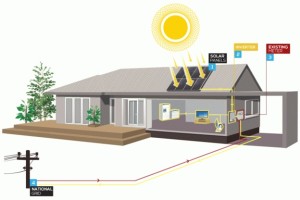
Grid-Tied or Grid Connected Solar Panel Systems
Grid-tied or grid connected solar power system connected to the power grid virtually act like a battery, that doesn’t need maintenance or replacement, and is more efficient than conventional battery systems. The biggest perk of using a grid-tied solar panel system is the availability of backup power from the utility grid that also helps mitigate the utility company`s peak load. The most common type of solar PV system, a grid connected system allows end users to avail benefits of both solar energy as well as electricity from the grid. As a result a grid-tied system doesnt have to work 100% capacity to meet power demand of a home or business. When there is no demand, excess electricity produced by solar panels is sent back into the power grid for use elsewhere, thereby boosting power availability of the grid.
When a home or business uses solar energy, but the panels don’t produce enough energy (at night, or a stormy day), power supply from grid compensates for the shortfall from the panels. All the owners of a grid connected solar power system need to do is t enter into a net metering agreement with their utility company that allows them to receive credit for the excess power generated from solar panels which is more than their requirement. The credit is given basis of kilowatt-hour credit on the next month bill. However net metering policies and agreements are generally different in each state as such credits received can vary from state to state.
As power from grid-tied solar PV system is similar to utility power, except for electricity produced from the sun; it doesn’t provide protection against power outages and if electrical grid fails, grid-tied systems cease to operate. However, this allows utility employees to fix the problem without worrying about identifying solar PV systems whether they are still feeding electricity into utility grid.
Advantages of Grid-Tied Systems
- Save Money via Net Metering – A grid-connected solar power system helps save money via net metering coupled with low equipment and installation cost are generally cheaper and easy to install. Using net metering, homeowners can send the excess electricity generated back into the utility grid instead of storing them in batteries and gain credits. Net metering as an incentive allows a residential complex to fully utilize the potential of solar PV systems. Many utility companies buy electricity from homeowners with grid-connected solar power system at the same rate they sell to others.
- A Virtual Battery – Electricity is best spent in real time. Grid-connected solar panels provide unlimited ‘on demand’ energy often generating power much more than needed. The excess power can be stored in batteries for emergency. On the other hand Off-grid systems must have batteries to be fully functional that pushes up their costs. Grid-tied solar systems are generally cheaper and simpler to design, maintain.
Disadvantages of Grid-Tied Systems
- Less Incentive to Conserve – In a grid connected home without a battery there are no backups. Though not a serious drawback for an urban area, where power supply is almost normal the year round, but it can be a serious issue in rural or semi urban areas. However, even if a battery backup is used in a grid connected systems it will only provide very limited backup. If there’s no sun on a particular day even the battery bank wont work.
- Red Tape Obstacles – while grid-tied solar power systems are attractive from the outset but setting up a solar PV system is often tangled in red tape, which can be a huge obstacle. Depending on the rules and utility company that the users have to deal with; the troubles can vary. While gaining approvals for setting up a solar photovoltaic plant from inspection agencies and utilities for a residential unit can be time consuming affair. However, if many users already exist in the area it may take less time, but if its being installed for first time it may happen that authorities or utilities may be ignorant about modalities for setting up solar PV system.
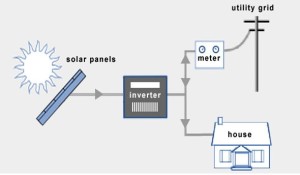
Equipment for Grid-Tied Solar Systems
There are variety of equipment other than solar panels installed for use in grid-tied or grid connected solar systems. These include the following components:
Grid-Tied Inverter (GTI)
A grid connected solar inverter regulates the voltage and current received from solar panels. They are used to convert Direct Current (DC) from solar panels into Alternating Current (AC), which is the current used in most electrical appliances. These inverters, also known as synchronous inverters, actually synchronize the phase and frequency of current so that it fits the utility grid. The output voltage is also managed at slightly higher than grid voltage to allow excess electricity produced to flow towards the grid.
Micro-Inverters
Micro-inverters are attached to every solar photovoltaic panel, as against a single central inverter that goes with entire solar array. Micro-inverters though more expensive, but are useful in terms of their high yield efficiency rates. Residential units opting for solar PV panels who are beset with shading issues should use a micro-inverter.
Power Meter
As homeowners install solar PV systems the first thing they need to opt for, is a compatible power meter for net metering. Often called a net meter or two-way meter, its used for measuring power going in both directions, from the grid to the residential unit and vice versa. In some instances the utility company itself supplies a power meter for free/or at a price.
Off-Grid Solar Power Systems
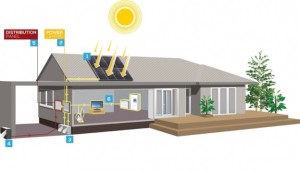
An off-grid or standalone solar power system is an alternative to grid-tied solar power system. Unlike the grid connected systems, off-grid solar systems require a huge bank of battery to store the power generated using solar panels during the day and use it at night time. It also needs a backup generator, making it far more expensive to setup and maintain. Despite reduced system efficiency, being more complex and less flexible; an off-grid solar power system is essential in rural, semi urban areas that are off the grid or face frequent power outages.
An off-grid solar system also comes in handy during rainy days or the days when the sun isn’t shining to power the home using the power stored in the batteries. Despite reduction in prices of solar panels and increased subsidy by central/state governments for adoption of solar power, a battery of number of batteries based on the requirement also pushes up the cost of off grid solar power systems. Unlike grid-connect solar PV system that are mostly based on same standard; off-grid solar power systems work the best when custom designed as per the requirement of the end user considering factors like electrical loads and daily use patterns to meet 100% energy needs of a building/office/boat/farm equipment like remote agricultural pumps, gates, and even remote traffic signs.
As off-grid systems are independent from the local power grid electrical usage needs to be monitored on regular basis to check power wastage under control and below the maximum output capacity of the solar panels and batteries as there are options available to supply excess power.
Advantages of Off-Grid Solar Systems
- No Access to Utility Grid – Off-grid solar power systems can be a cheaper option rather than spending money on setting permanent structures like transmission towers and power lines to provide uninterrupted power in remote areas.
- Promotes Energy Self-Sufficiency – People who live using standalone systems become self-sufficient in terms of energy usage over a period of time. This helps them not only to save money but also helps them get rid of problems like power failures, load shedding , low voltage as it doesn’t affect a off-grid solar PV system.
- Judicious Use of Power – Habit of judicious of power gets inculcated into the users daily routine as off grid systems majorly depend on power stored in batteries (during days when there is no or little sun or during rainy season) that are expensive and have relatively short life of 5-10 years depending on use. If batteries don’t work the people have to make do with generators, which is again a costly backup item.
- No Effect of Power Rate Hike – once a off grid solar PV system is installed users tend to stop worrying about electricity rate hikes. As a one-time investment and occasional maintenance cost it doesn’t have much effect on the end user purse with power literally becoming free within a few years.
Disadvantages of Off-Grid Solar Power System
- High Initial Investment – Installing an off-grid solar power system can be of high initial cost, with necessary expenditures such as reinforcing the roof (in case of rooftop unit), clearing the land of undulating surface (in case of ground unit), buying maximum number of solar panels that maximize power output. Apart from these expenditure on fittings, wires, brackets, cement blocks (in case of ground unit) are also needed apart from batteries to store power and generator.
- Lack of Financial Incentive – As disappointing as it may sound; financial incentives are mostly available for on-grid solar power systems and rarely applied to standalone solar power systems supported by batteries in remote locations. One big reason could be that since utility grids dont gain anything from an off grid system; incentives by government aren’t forthcoming as utilities don’t find it viable to check or survey a location for installing a off grid solar power system in remote areas. The survey being key for granting government approval of financial incentive.
- Lack of Support – Installing an off-grid solar power system is easy but its maintenance is a big issue. As its not supported by utilities it may require the end user/owner themselves to learn basic repair and maintenance methods. This is important as being located in remote areas, its quiet possible that technical maintenance expert may not be available every time a breakdown occurs; or may be unwilling to travel to remote location unless paid hefty amount for the visit
- Recurring Expenditure on Batteries– Off-grid solar power systems use batteries to store power generated in the morning for use in evening. But batteries are prone to overuse/overcharge/power surge/degrading efficiency. All these factors make it essential to replace the batteries every 5 to 10 years (unless industrial scale batteries are used that can last 15 years). In any case either some number of batteries have to regularly replaced every few years or the entire bank of batteries has to be replaced in one go. All this can burn a hole in the pocket of end user.
- Enforced Changes in Schedule–Off-grid PV systems stop producing power once the backup batteries are full to their limit. While in case of wind/hydel assisted hybrid system, power generation continues; general off grid system users make sure that after power packs/batteries are completely charged the solar systems continue to generate power by diverting excess energy to a dump load, such as a water-heating element that both be used for bathing as well as washing cloths’. As such end users may be forced to make adjustments to their routine like bathing as well as washing around the time after back up batteries are fully charged.
- Need for Backup Generator – Off-grid PV/standalone systems need a backup generator, as an ultimate backup when everything else fails; including solar panels due to non availability of sunlight and backup batteries that use up the power stored in them to compensate for solar panels inability to produce power. The backup generator/geneset are not only expensive to maintain but use diesel, a potential pollutant as fuel. When a generator is operated it not only causes noise pollution but smoke pollution from fumes ultimate defeating the purpose of setting up a off grid solar power energy system which is actually meant to conserve energy cut use of non renewable fuel and save environment.
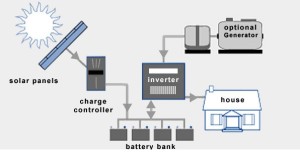
Equipment for Off Grid Solar Power Systems
There are numerous equipment needed other than solar panels installed for use in off grid solar power systems. These include the following components:
Solar Charge Controller
A Solar charge controller also known as charge regulator is used to regulate solar battery charger limit. It helps to vary the rate of current that is delivered to the battery bank and protects batteries from being overcharged. These controllers’, actually help in extending the life of a battery bank. In case of a battery-based inverter, the charge controller is integrated in most cases.
Battery Bank
As mentioned earlier off-grid solar power systems use batteries to store power generated in the morning for use in evening. As such without a battery bank wired in; the off grid solar power system will become useless.
DC Disconnect Switch
Its known that AC/DC safety disconnects are essential for all solar systems. In case of off-grid solar systems, a additional DC disconnect needs to be installed between battery bank and off-grid inverter to ensure there is no damage to equipment due to power surge/overheat or any other issue that may result in electrical fire. It switches off the current flowing between the other components that also helps in carrying out essential maintenance activities.
Off-Grid Inverter
An off grid inverter is a must to convert DC to AC for use with regular use electrical appliances. Off-grid inverters dont have to match phase with utility sine wave as compared to grid-connected inverters. The electrical power flows from the solar panels through the solar charge controllers to the battery bank; before that its converted into AC by the off-grid-inverter.
Backup Generator
As mentioned earlier batteries run of charge if there are few consecutive days without proper sun shine. As such to keep the electrical appliances in the remote location a backup generator is must. A backup generator that runs on diesel, petrol, propane, gasoline and any other fuel is a better choice to meet any eventuality in case everything else fails. A backup generator typically produces AC power that can be sent through the inverter for direct usage of electrical appliances or can be converted into DC power for charging the battery bank.
About Vivaan Solar
Vivaan Solar as a EPC contractor is a solar PhotoVoltaic system installer & integrator. We have installed 60 MW solar park in Madhya Pradesh, 5 MW in Punjab, 8 MW in Uttarakhand and an upcoming park in Karnataka. We are also MNRE accredited channel partner for Rooftop. We have done turnkey works for multiple companies across the country and has third party agreements with some of the leading industries/commercial institutions across the state. We are an MNRE accredited channel partner. For more info you can visit our website: www.vivaansolar.com or contact us at mail- info@vivaansolar.com.
Sources
http://powersmartsolar.co.nz/what-is-the-difference-between-grid-tied-and-off-grid-solar-electricity-systems
http://energyinformative.org/grid-tied-off-grid-and-hybrid-solar-systems/
http://solardirectory.in/2016/05/grid-tied-vs-off-grid-solar-power-systems/
http://solarsimplified.org/connecting-to-the-grid/solar-and-storage/item/48
https://www.homepower.com/articles/solar-electricity/design-installation/or-grid

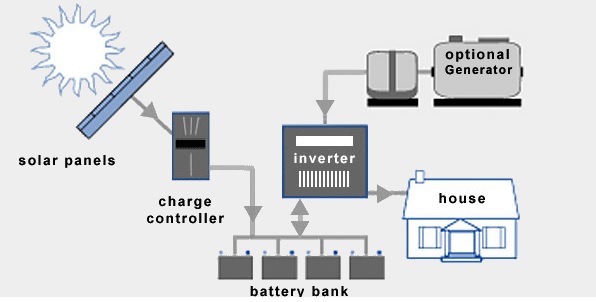
Please quote for 1 KW on grid and 3 KW off grid on the same house at opmaharshi@gmail.com
Thanks
dear
sir/madam
Thanks for the appreciation for writing the blog and do spread the word about our blog.
We do like to share useful information on solar power and renewable energy and technology and add our perspective and please share the info with your friends.
Keep watching this space for the latest blog updates and do watch our social media profile.